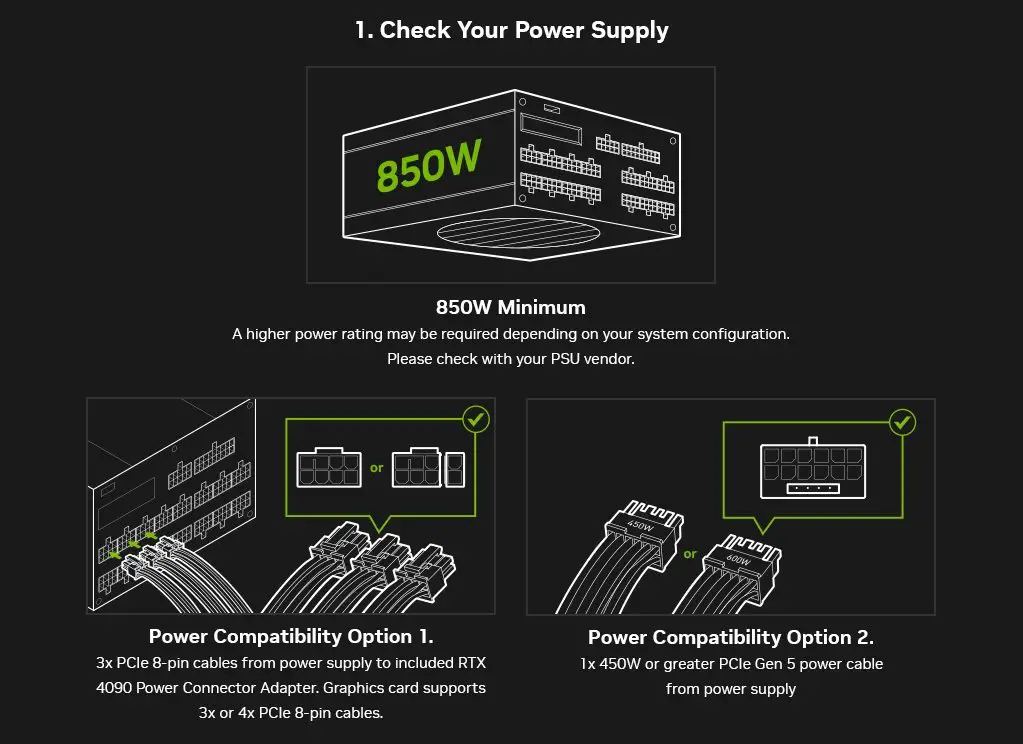With the upcoming release of the new NVIDIA GeForce RTX 40 series GPUs starting with the RTX 4090, there are a lot of things and issues surrounding the cards and associating components like the power cables and wattage consumption. Just yesterday, Team Green’s representatives uploaded a new blog post detailing all the questions and answers so that the first wave of supporters will have full knowledge of what they are dealing with.

To sum it up quickly, you don’t need a new PSU if you already met the power rating requirements but as a tip from us, be sure to always leave like a 100W to 150W headroom since starting with the RTX 30 series cards they tend to surge and spike a lot more during the initial load ramp up and don’t ever use one from a sketchy brand that you never heard of.
But anyway, we’ll try to simplify and talk about only the important bits within the FAQ provided by NVIDIA.
- Do I need to upgrade my PSU for the RTX 40 Series?
- Nope as we mentioned above. The RTX 4090 TGP is at 450W with a minimum recommended PSU rating of 850W. The numbers for the RTX 4080 16GB is 320W/ min 750W and 320W/min 700W for RTX 4080 12GB.
- How do GeForce RTX 4090 and 4080 power requirements compare to the last generation?
- On paper, the RTX 4090 matches the RTX 3090 Ti while the RTX 4080 16GB is 30W less than RTX 3080 Ti, and the RTX 4080 12GB is 65W than RTX 3080 12GB.
- Do the RTX 40 Series cards require a new type of power connector or a new power cable?
- Existing power supplies can directly plug the 8-pin PCIe power connector into the new power adapter provided with each RTX 40 series GPU OR with a PCIe Gen5 power connector if your PSU supports that output.
- If the RTX 40 Series cards can use the existing connectors and power supplies, then why change to a new connector standard?
- The PCIe Gen5 power connector is a new standard that focuses on delivering all the power a GPU needs with a single cable, simplifying cable routing and the total amount of cables dangling inside the rig.
- PCI-SIG warned of potential overcurrent/overpower risk with 12VHPWR connectors using non-ATX 3.0 PSU & Gen 5 adapter plugs. Why did PCI-SIG issue the warning and how does this affect NVIDIA’s new products?
- The issue does not affect NVIDIA products as the potential issue comes from a prototype unit from a supplier but has been fixed since then and is now circulating the newly updated design towards other suppliers as well.
- Why is there only a 30-cycle lifetime on these new PCIe Gen 5 connectors?
- It is the same rating given to the PCIe/ATX 8-pin connectors if you have not been informed yet. But actual milestones may still vary.
- What’s a ‘smart’ power adapter?
- A power adapter fitted with an IC chip that detects and reports the power capacity based on the number of 8-pin connectors plugged in. With the correct setup, the RTX 4090, for example, can obtain more power headroom for overclocking when 4 8-pin connectors are detected but not when only 3 are plugged in.
- If I bend the RTX 40 Series adapter will it cause issues with the connection between my PSU and GPU?
- Although it is discouraged, the RTX 40 series adapter is tested to work and withstand a variety of conditions. But as usual, don’t overdo it.
- Should I be concerned if my PSU only has one power rail available to connect my graphics card (i.e. only have 1 power connection available)?
- Users are advised to just connect the original PSU output connectors directly into the power adapter with the usual ones supplying only up to 2 8-pin PCIe connectors. The RTX 4090 and RTX 4080 16GB requires at least 3 (4 is best) or a single one of the PCIe Gen5 connector.
The full blog post is right over here with more information.








